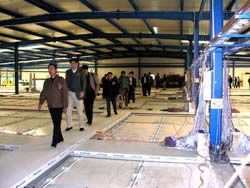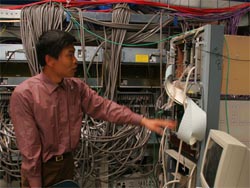

The construction of the main detector of the Astroparticle-physics Research at Ground-based Observatory Yangbajing Experiment (dubbed the YBJ-ARGO Experiment) has been completed and put into full operation recently.
Its celebration ceremony was recently held in Lhasa, capital of the Tibet Autonomous Region, with the participation of officials and scholars from the local government, CAS, Italy's National Institute of Nuclear Physics (INFN), the National Natural Science Foundation of China (NSFC) and Italian Embassy to China.
Launched by Chinese and Italian scientists in 1994 and under the joint support of the Chinese Ministry of Science and Technology, CAS, NSFC and INFN, the YBJ-ARGO is an atmospheric cosmic ray shower array experiment that boasts a 5,000 m
2 full coverage carpet-like resistive plate chamber (RPC) array to realize the low threshold energy high sensitivity detection of the primary γ-ray and cosmic ray particles.
It will be conducted at the Yangbajing Cosmic Ray Observatory, the CAS Institute of High Energy Physic, which is considered one of the best sites for high altitude observation thanks to its 4,300m elevation, wide and flat geography, mild climate, easy traffic, sufficient electricity supply and the necessary public services.
Known as the Central Carpet, the main detector is a complicated system, which is composed of 130 clusters, with each cluster consisting of 12 RPCs and each RPC being further divided into 10 detector units. The completion marks the shift of the work focus of YBJ-ARGO project from infrastructure construction to operation, and the start of the physical analysis in an all-round way.
At the ceremony, the Chinese side reported the cooperation and organization of ARGO Experiment both in China and abroad, its progress and some preliminary results of physics analyses. The arduous work of the ARGO Collaboration Group under the extreme hard plateau conditions, the high performance of the Carpet and the leading role of Chinese scientists in the Experiment were greatly praised.






